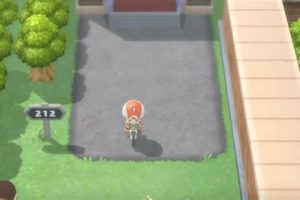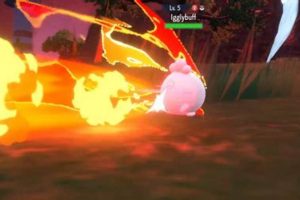This puzzle variant combines the popular “2048” game mechanic with elements from the Pokmon franchise. It typically involves sliding tiles on a grid, merging identical tiles to create a tile with a higher value, represented by different Pokmon characters or evolutions. The objective is generally to reach a specific target value, often represented by a powerful or iconic Pokmon.
The adaptation leverages the familiarity and appeal of both the original numerical puzzle and the globally recognized world of Pokmon. This integration creates an engaging experience that can attract a broader audience, potentially introducing the puzzle to Pokmon enthusiasts and vice versa. The visual appeal of Pokmon characters provides a more stimulating alternative to simple numerical tiles, enhancing the game’s addictiveness and replayability. This type of derivative work builds upon established intellectual property to create novel interactive experiences.
The following sections will delve further into aspects related to this specific game variant, analyzing its appeal, game mechanics and its position within the broader landscape of puzzle adaptations.
Strategic Guidance
The subsequent points offer insights to improve proficiency within this puzzle adaptation. Mastery requires understanding of both tile merging strategy and the hierarchical progression of Pokmon.
Tip 1: Prioritize a Corner. Focus building the highest-value tiles in one corner of the grid. This restricts tile movement, however, creates opportunities for controlled merges.
Tip 2: Maintain Monotonicity. Arrange tiles in descending order, either horizontally or vertically. This arrangement facilitates efficient merging and prevents gridlock.
Tip 3: Plan Several Moves Ahead. Consider the consequences of each slide, anticipating how new tiles will populate the grid and affect the overall arrangement.
Tip 4: Avoid Random Slides. Resist the urge to slide tiles without a clear objective. Unplanned movements can disrupt established patterns and decrease scoring opportunities.
Tip 5: Utilize the ‘Up’ Direction Strategically. The upwards direction should be used sparingly and with caution. It can lock the highest value in an unideal location and cause future problems.
Tip 6: Adapt to the Pokemon Hierarchy. Understand the evolution levels. Focusing on obtaining earlier merges provides higher efficiency.
Tip 7: Value board space. When you have a full board and no merges you lose.
Effective gameplay relies on thoughtful planning, strategic tile arrangement, and an understanding of the underlying numeric and the Pokemon hierarchies.
The final section will explore potential extensions and future developments for this game.
1. Character Hierarchy
The “2048 pokemon” adaptation utilizes a character hierarchy to represent increasing tile values within the game. This hierarchy is typically based on Pokmon evolution stages or relative strength, creating a tangible progression system that resonates with players familiar with the franchise.
- Evolutionary Stages
The most common approach involves using Pokmon evolution lines as the basis for the hierarchy. For example, a starting tile might feature a basic Pokmon like Bulbasaur, which then evolves into Ivysaur, Venusaur, and potentially a Mega Venusaur form as tiles are merged. This progression mirrors the core mechanics of the Pokmon games, providing a clear and intuitive understanding of the tile value system.
- Power Scaling
Another method involves assigning Pokmon based on their perceived power levels within the franchise. This could involve using base stats, in-game roles, or competitive viability as criteria. For example, weaker Pokmon might represent lower-value tiles, while legendary or mythical Pokmon signify higher values. This approach requires careful consideration to ensure that the chosen Pokmon are easily recognizable and that their power levels are generally accepted by the fanbase.
- Rarity and Collectibility
In some implementations, the character hierarchy may be influenced by the rarity and collectibility of specific Pokmon. Rare or sought-after Pokmon, such as shiny variants or event-exclusive creatures, could be used to represent high-value tiles. This adds an element of desirability and encourages players to strive for higher scores in order to “collect” these virtual Pokmon.
- Visual Distinction and Memorability
Regardless of the specific criteria used to establish the hierarchy, the chosen Pokmon should be visually distinct and easily memorable. This ensures that players can quickly identify the value of each tile and make informed decisions during gameplay. Iconic Pokmon with recognizable designs are generally preferred over less familiar or visually similar creatures.
These different facets provide a layered complexity that increases user engagement. The effectiveness of the hierarchy directly impacts the overall appeal and replayability of the “2048 pokemon” adaptation. Careful selection and arrangement of characters are critical to creating a satisfying and challenging puzzle experience.
2. Tile Merging
Tile merging represents the core mechanic underpinning the puzzle. The successful combination of tiles is fundamental to progression and achieving higher scores within this variant of the game.
- Numerical Progression
In “2048 pokemon,” tile merging facilitates a numerical progression typically represented by the exponential increase of powers of two (2, 4, 8, 16, etc.). Each successful merge combines two identical tiles, resulting in a single tile with a value twice as large. This sequence is essential for reaching the target tile, often associated with a high-value Pokmon. The predictable nature of this sequence requires players to strategize based on additive properties.
- Character Evolution Representation
The act of merging directly reflects the concept of evolution within the Pokmon universe. The combination of two identical tiles, each depicting a specific Pokmon, produces a new tile featuring its evolved form or a more powerful alternative. This visual and thematic connection to the source material enhances player engagement and provides a clear sense of progression beyond the numerical value.
- Strategic Grid Management
Efficient tile merging necessitates careful management of the game grid. Players must consider the positioning of tiles and the consequences of each move to create opportunities for future merges. Blocking the board with mismatched tiles impedes progress, emphasizing the importance of strategic planning and anticipation. The ability to effectively clear space and consolidate tiles is crucial for achieving high scores and reaching advanced stages.
- Resource Management of Moves
Each move within the game consumes a limited resource: available grid space. Random tile generation following each move introduces an element of chance that necessitates adaptive strategies. Tile merging becomes a means of conserving grid space, allowing players to extend gameplay and increase their chances of obtaining the target tile. The careful balancing of tile consolidation and grid management defines the skill ceiling of the game.
In sum, tile merging is not merely a mechanical action but an integrated system reflecting numeric progression, thematic evolution, strategic planning, and efficient resource management. Mastery of this mechanic defines success in the “2048 pokemon” puzzle variant.
3. Grid Optimization
In the “2048 pokemon” puzzle variant, grid optimization is a critical determinant of success. The limited space within the game board demands efficient tile management, as a cluttered or disorganized grid quickly leads to blocked pathways and lost opportunities for merging. A well-optimized grid facilitates smooth tile movement and allows for the creation of high-value tiles by strategically positioning identical Pokmon for subsequent merges. The underlying cause is the constraint of a fixed grid size coupled with random tile generation, which necessitates proactive organization to overcome inherent challenges.
Effective optimization involves several key principles. Corner anchoring, where the highest-value tile is strategically placed in a corner to restrict its movement and provide a stable base for merging, is a prevalent technique. Maintaining monotonicity, arranging tiles in descending order across rows or columns, allows for cascading merges and prevents premature gridlock. Proactive planning, anticipating the consequences of each move and visualizing future tile placements, is crucial for long-term strategic success. Disregarding these principles results in a suboptimal board state, exemplified by isolated high-value tiles that cannot be merged, ultimately leading to a game-over scenario. This is similar to resource allocation problems in operations research.
The practical significance of understanding grid optimization lies in its direct impact on gameplay outcomes. Mastering these techniques allows players to consistently achieve higher scores and unlock more advanced Pokmon tiles. Furthermore, the cognitive skills developed through optimizing the game grid, such as strategic thinking, spatial reasoning, and problem-solving, can be applied to various real-world situations. Ultimately, grid optimization serves as the foundation for skilled play, transforming the seemingly simple game into a complex strategic endeavor. Without the optimization skill, a user might not be able to achieve the ultimate Pokemon on the tile.
4. Strategic Anticipation
Strategic anticipation forms a cornerstone of proficient gameplay within the “2048 pokemon” puzzle. The game’s mechanics, characterized by random tile generation and a finite grid, necessitate careful consideration of future states. Each slide not only affects the immediate arrangement of tiles but also dictates the subsequent placement of a new tile, introducing an element of uncertainty that demands foresight. A lack of anticipation invariably leads to a cluttered grid, hindering merging opportunities and ultimately culminating in a game-over scenario.
The ability to project several moves ahead distinguishes experienced players from novices. This involves visualizing potential tile placements, predicting their impact on the existing configuration, and formulating plans to maximize merging opportunities while minimizing the risk of gridlock. For example, a player might intentionally create an empty space in a strategic location to facilitate the future merging of two high-value tiles, understanding that the subsequent tile generation will likely fill that space. Similarly, anticipating the potential for blocked pathways can prompt a player to execute a less-than-optimal move in the short term to prevent future complications. The game’s challenge derives not simply from immediate tile combinations but from the necessity of long-term planning within a probabilistic environment. Successful players learn to manage the inherent randomness, converting it into a manageable variable through strategic foresight.
In summary, strategic anticipation is not merely an advantageous tactic but a fundamental requirement for achieving high scores and mastering the “2048 pokemon” puzzle. It transforms the game from a reactive exercise into a proactive endeavor, demanding that players not only adapt to immediate circumstances but also shape the future state of the grid to their advantage. The capability to anticipate, assess risk, and plan accordingly is the linchpin of skilled gameplay and the key to unlocking the game’s full potential. The long-term advantage this provides outweighs any potential short-term losses.
5. Visual Appeal
In the “2048 pokemon” game variant, visual appeal is not merely an aesthetic consideration but a critical factor that significantly influences player engagement and overall enjoyment. The integration of recognizable characters from the Pokmon franchise transforms a purely numerical puzzle into a more stimulating and engaging experience.
- Character Recognition and Nostalgia
The utilization of recognizable Pokmon characters leverages the power of nostalgia and brand recognition. Players familiar with the Pokmon franchise are more likely to be drawn to the game due to its familiar visuals. The act of merging tiles featuring beloved characters triggers positive associations and enhances the sense of accomplishment. This tactic leverages existing brand equity to attract and retain players. Successful characters can include Pikachu or Charizard.
- Thematic Consistency and Immersion
Consistent visual themes create a more immersive gaming experience. By aligning the visual style with the established aesthetics of the Pokmon universe, the game fosters a sense of authenticity and coherence. This includes using consistent color palettes, character designs, and graphical elements that are characteristic of the franchise. A visually consistent environment aids in player immersion, making the game more captivating. Inconsistencies such as varying art styles can break the immersion.
- Progression and Reward
Visual progression serves as a tangible reward for successful tile merging. As players combine tiles, they are visually rewarded with the appearance of more powerful or evolved Pokmon. This visual feedback reinforces the sense of progress and motivates players to continue playing. The transformation of a basic Pokmon into its evolved form provides a visual representation of the player’s achievement. For example, Charmander to Charizard. This visual feedback loops directly impacts the player experience.
- Differentiation and Memorability
Effective visual design ensures that each Pokmon tile is easily distinguishable from others. Clear and distinct character designs prevent confusion during gameplay and facilitate strategic decision-making. This requires careful consideration of color palettes, character poses, and overall visual clarity. Memorable visuals contribute to the game’s overall appeal and make it more likely to be shared and recommended to others. Confusing designs would inhibit gameplay.
In conclusion, the visual appeal of the “2048 pokemon” game extends beyond mere aesthetics. It encompasses character recognition, thematic consistency, visual progression, and differentiation, all of which contribute to a more engaging, rewarding, and memorable gaming experience. The effective integration of these visual elements transforms the puzzle into a product that resonates with fans of both the original numerical game and the Pokmon franchise, increasing its overall appeal and marketability. Further, this combination provides a unique perspective for both “2048” and “pokemon” fans, creating cross-marketing potential.
Frequently Asked Questions
This section addresses common inquiries and provides clarification regarding the mechanics and strategies associated with the “2048 pokemon” puzzle variant.
Question 1: What is the objective of the “2048 pokemon” puzzle?
The objective is to merge tiles, each depicting a Pokmon character, to reach a specific target tile, often representing a high-value or evolved Pokmon. The merging process follows the numerical progression of the original “2048” game.
Question 2: How does the character hierarchy influence gameplay?
The character hierarchy, typically based on Pokmon evolution stages or power levels, dictates the sequence in which tiles merge. Understanding this hierarchy is crucial for strategic planning and efficient tile management.
Question 3: What strategies are most effective for optimizing the game grid?
Effective grid optimization strategies include corner anchoring (placing the highest-value tile in a corner), maintaining monotonicity (arranging tiles in descending order), and anticipating future tile placements.
Question 4: How does random tile generation impact strategic decision-making?
Random tile generation introduces an element of uncertainty that requires adaptive strategies. Players must anticipate potential tile placements and adjust their plans accordingly to maximize merging opportunities while minimizing the risk of gridlock.
Question 5: What is the significance of visual appeal in the “2048 pokemon” adaptation?
Visual appeal, derived from recognizable Pokmon characters and consistent thematic design, enhances player engagement and enjoyment. It transforms a purely numerical puzzle into a more stimulating and rewarding experience.
Question 6: What distinguishes “2048 pokemon” from the original “2048” game?
The primary distinction lies in the integration of Pokmon characters and themes. This adds a layer of complexity and engagement beyond the purely numerical progression of the original game, appealing to fans of the franchise.
Understanding these fundamental aspects of the “2048 pokemon” puzzle can significantly improve gameplay proficiency and overall enjoyment.
The subsequent section will explore potential variations and future iterations of this game.
Conclusion
This exploration has illuminated key aspects of the “2048 pokemon” puzzle variant. The integration of the “2048” game mechanic with elements of the Pokmon franchise results in a unique and engaging puzzle experience. The success of this adaptation depends on the strategic implementation of its underlying components: the hierarchical progression of characters, efficient tile merging, optimized grid management, anticipation of random tile generation, and compelling visual appeal.
Future iterations of “2048 pokemon” and similar adaptations should focus on refining these core elements to further enhance player engagement and challenge. The potential for continued innovation within this hybrid genre remains substantial, offering opportunities to create even more compelling and rewarding puzzle experiences. Careful consideration and skilled execution are essential for realizing its full potential.







